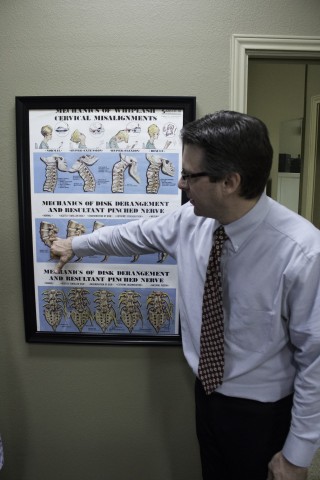When a spinal bone loses its proper position and motion, this is called a vertebral subluxation complex (or subluxation for an abbreviated synonym for purposes of this discussion).
The relationship of the disc and subluxation is crucial to the Gonstead chiropractic method.
The nervous system can be negatively affected if proper spinal alignment is altered even slightly between one spinal bone (or vertebrae) and another. The area where the spinal nerves exit the spine (the intervertebral foramen) can become narrowed causing pressure, irritation, or stretching of the nerve. Research has shown that even slight pressure, as little as the weight of a dime, can alter the function of a nerve.
When a vertebra loses its normal position it also loses its ability to move properly. An improperly moving vertebrae (or fixed vertebrae) has been show to alter spinal reflexes. Spinal reflexes are a means for the body to relay messages from the body to the spinal cord and vice versa. A fixed vertebra causes these nerve impulses to become scrambled.

The nervous system allows the entire body to function at its optimum level. When there is a problem with nervous system, it can interfere with the function of the entire body.
For example, irritation of the nerves going to the stomach or intestines will affect the transmission of information from the brain to the gastrointestinal system. This situation may cause a person to suffer from ulcers, indigestion, constipation, diarrhea, or other gastro-intestinal conditions.
Many individuals do not realize that the underlying cause of their diseased condition may actually be a subluxation. A subluxation and the widespread effects it has on the body are collectively called the Vertebra Subluxation Complex.
The Vertebral Subluxation Complex is identified by:
Many factors can cause or contribute to the Vertebral Subluxation Complex. Subluxation degeneration results from spinal neglect, as well as from existing subluxations that are ignored or go untreated. Trauma from car accidents, improper lifting, falls, jolts, or strains are all common causes. Sustained postures (sitting all day), repeated motions common to the workplace, inadequate sleep, improper exercise, poor diet, drug side effects and emotional stress are also factors that can gradually wear down parts of the spine and lead to subluxation.
Subluxations can even occur as early as childbirth. An infant’s spine (particularly the neck) undergoes an incredible amount of stress during the birthing process, and many neurological health problems have been traced to spinal trauma at birth.
A doctor of chiropractic is trained and experienced at detecting, reducing, correcting and preventing the Vertebral Subluxation Complex.
Dr. Handlos conducts a thorough evaluation of your spine and addresses those specific areas of subluxation only. The longer a subluxation has to degenerate, the worse it affects your body’s functions and the more difficult it is to correct. For these reasons, it is important to have periodic spinal checkups.
© 2025 Handlos Chiropractic. All rights reserved.